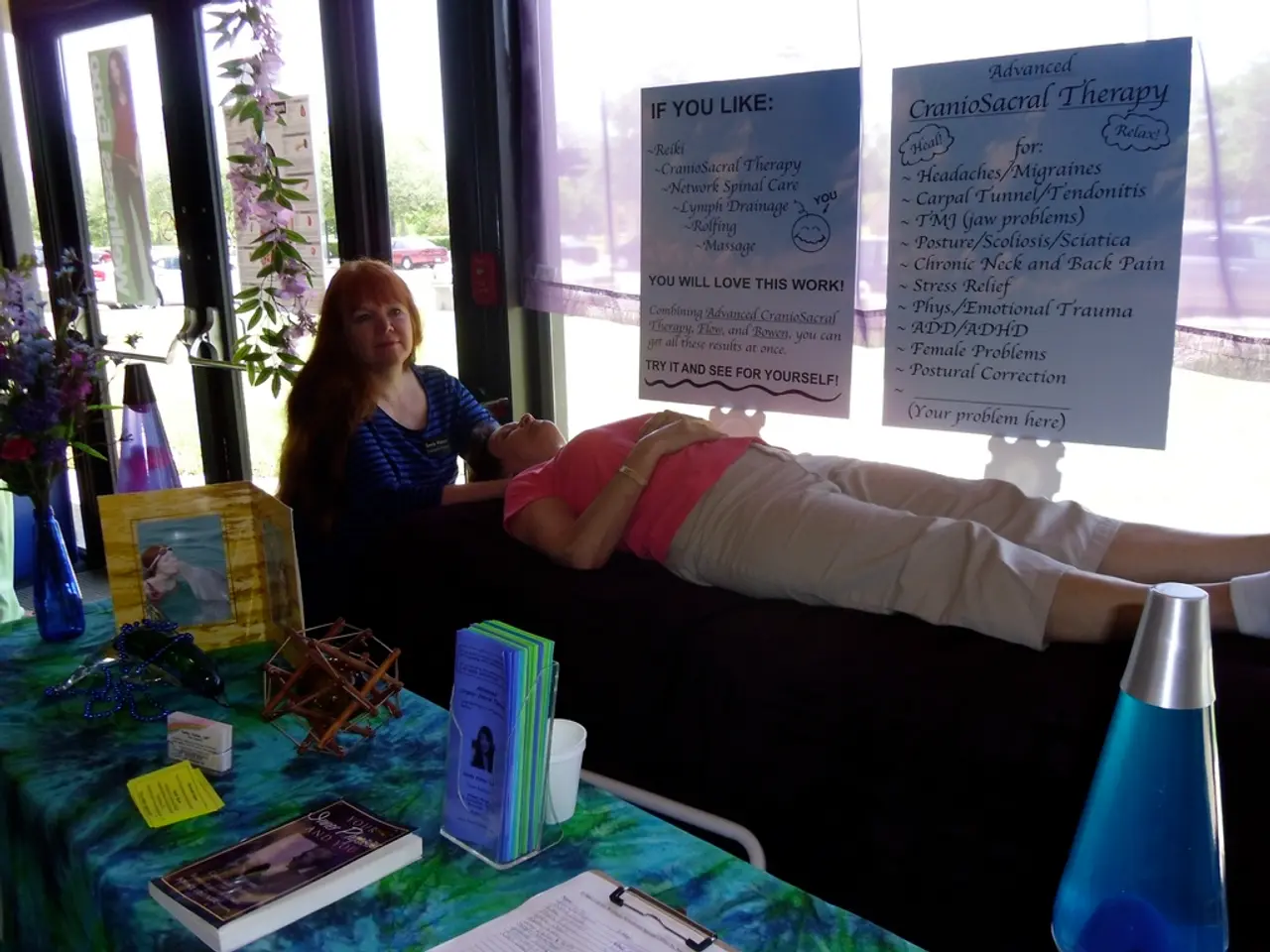Exploring Light Therapy: Its Nature and Advantages
In the realm of modern medicine, light therapy is making significant strides, transforming the way various health conditions are managed. With origins dating back to ancient civilizations such as the Egyptians, Greeks, and Romans, who practiced heliotherapy for treating ailments using natural sunlight, the evolution of this innovative treatment modality is truly remarkable.
Current advancements in light therapy highlight a significant expansion in both technology and accessibility. One of the key advancements is the widespread availability of at-home devices. Previously limited to clinics and professional spas, light therapy is now increasingly popular for home use. Devices such as LED facial masks and full-body beds enable users to treat conditions like acne, skin aging, inflammation, pain, and muscle recovery conveniently at home.
Modern devices employ a variety of wavelengths, each targeting specific concerns. For instance, blue light (around 415 nm) typically targets acne-causing bacteria, while red light (630–660 nm) promotes collagen production and reduces inflammation. Near-infrared light (around 830 nm) supports deeper tissue repair and pain relief. Additional colours like green and yellow address pigmentation and detoxification, respectively.
The integration of wearable biophotonics is another significant advancement, offering non-invasive, targeted treatment options with minimal side effects. These wearable devices enhance flexibility and personalization in therapy delivery.
Artificial intelligence is revolutionizing phototherapy by enabling real-time treatment adjustments, safety monitoring, and improved compliance. AI integration supports smart, app-connected at-home systems that guide users through therapy regimens and track progress effectively.
The global phototherapy treatment market is growing steadily, projected to rise from USD 1.77 billion in 2025 to USD 2.58 billion by 2034, driven by rising chronic skin conditions and demand for non-invasive therapies.
Looking ahead, the future prospects of light therapy are promising. Increased adoption of wearable and home-use devices due to their convenience and customization capabilities, enhanced by AI and mobile app integration, is expected. Broader therapeutic applications beyond dermatology, potentially expanding into pain management, mood disorders, and systemic diseases, are also on the horizon.
Continued improvement in device efficacy and user experience with wearable biophotonics and full-body light therapy beds becoming more sophisticated, offering comprehensive wellness benefits, is another exciting development. The growing acceptance in mainstream healthcare as more clinical evidence supports long-term remission and reduced side effects in conditions like psoriasis, eczema, and other immunodermatological diseases is further boosting the field.
Scientific studies validate the effectiveness of light therapy across various health domains, including mood, sleep, skin health, and pain management. One of the most well-documented uses of light therapy is in managing seasonal affective disorder (SAD), a condition characterized by depression, fatigue, and mood disturbances during the winter months.
Red and near-infrared light therapy promote cellular repair and reduce inflammation, aiding in muscle recovery and pain relief. Green light therapy is a newer modality showing promise in reducing migraines and managing pain sensitivity. Blue light therapy targets acne-causing bacteria, reducing inflammation and preventing breakouts.
Light therapy, also known as phototherapy, is a non-invasive treatment that uses specific wavelengths of light to address a variety of physical, mental, and emotional health conditions. It plays a crucial role in regulating the body's circadian rhythm, aiding sleep-wake cycles.
Today, light therapy has evolved into a versatile treatment supported by scientific research and advanced technology, encompassing various modalities, including bright light therapy, red light therapy, and blue light therapy. With its promise of convenience, customization, and effective treatment, light therapy is set to revolutionize healthcare in the near future.
- In the realm of modern medicine, light therapy's advancements in technology and accessibility are making a notable impact on health management.
- Light therapy's home-use devices, such as LED facial masks and full-body beds, have become increasingly popular, offering treatments for conditions like acne, skin aging, inflammation, pain, and muscle recovery.
- Blue light, typically around 415 nm, targets acne-causing bacteria, while red light, between 630–660 nm, promotes collagen production and reduces inflammation.
- Near-infrared light, around 830 nm, supports deeper tissue repair and pain relief.
- Green and yellow lights address pigmentation and detoxification, respectively.
- Wearable biophotonics integration offers non-invasive, targeted treatment options with minimal side effects.
- Artificial intelligence is transforming phototherapy by enabling real-time adjustments, safety monitoring, and improved compliance.
- The global phototherapy treatment market is projected to expand significantly, driven by rising chronic skin conditions and the demand for non-invasive therapies.
- Light therapy's potential applications beyond dermatology, such as pain management, mood disorders, and systemic diseases, are on the horizon.
- The device efficacy and user experience continue to improve, with wearable biophotonics and full-body light therapy beds becoming more sophisticated.
- These advancements offer comprehensive wellness benefits, growing acceptance in mainstream healthcare, and clinical evidence supporting long-term remission and reduced side effects in conditions like psoriasis, eczema, and other immunodermatological diseases.
- Scientific studies validate the effectiveness of light therapy across various health domains, including mood, sleep, skin health, and pain management.
- Seasonal affective disorder, a condition characterized by depression, fatigue, and mood disturbances during the winter months, is one of the most well-documented uses of light therapy.
- Red and near-infrared light therapy promote cellular repair and reduce inflammation, aiding in muscle recovery and pain relief.
- Green light therapy is a newer modality showing promise in reducing migraines and managing pain sensitivity.
- Blue light therapy targets acne-causing bacteria, reducing inflammation and preventing breakouts.
- Light therapy, or phototherapy, is a non-invasive treatment that uses specific wavelengths of light to address various physical, mental, and emotional health conditions.
- The versatility of light therapy lies in its encompassing various modalities, including bright light therapy, red light therapy, and blue light therapy.
- Light therapy plays a crucial role in regulating the body's circadian rhythm, aiding sleep-wake cycles.
- As technology continues to evolve, the integration of virtual reality in light therapy could offer immersive, personalized experiences for users.
- In finance, investors explore opportunities within the light therapy industry, recognizing its potential for growth and innovation.
- CBD companies are looking into the benefits of light therapy in conjunction with their products, aiming to provide holistic approaches to health and wellness.
- Neurological disorders, such as Alzheimer's disease and Parkinson's disease, could potentially be treated with light therapy, thanks to emerging research in environmental science.
- Experts in mental health suggest that light therapy could help individuals manage stress, anxiety, and depression, especially during challenging periods like the ongoing pandemic.
- In cybersecurity, protecting sensitive data related to personal health and wellness, including medical records and light therapy treatment plans, is becoming increasingly important.
- Lifestyle choices, such as proper nutrition, fitness, and exercise, combined with light therapy, can lead to improved overall well-being.
- Climate change's impact on our environment and the increasing prevalence of skin conditions make it essential to embrace innovative and effective treatments like light therapy.
- In the fashion and beauty industry, light therapy devices, such as MIYU's Youth Preserve Eye masks, are gaining popularity, addressing aging, dark circles, and puffiness around the eyes.
- In movies and TV, lighting can drastically impact a scene's mood and tone, drawing parallels to the way light therapy influences emotional states.
- With ever-growing technological advancements, the future of light therapy is brimming with possibilities, spanning across various aspects of life, including entertainment, pop culture, and scientific exploration.








